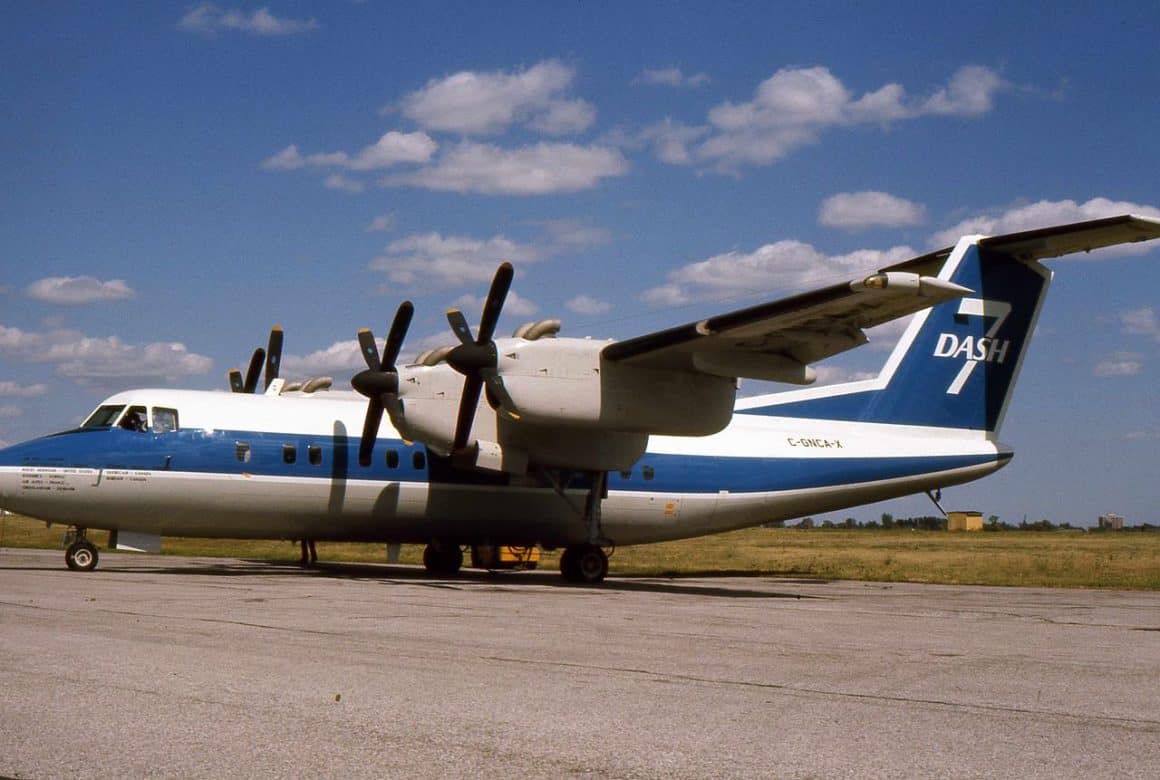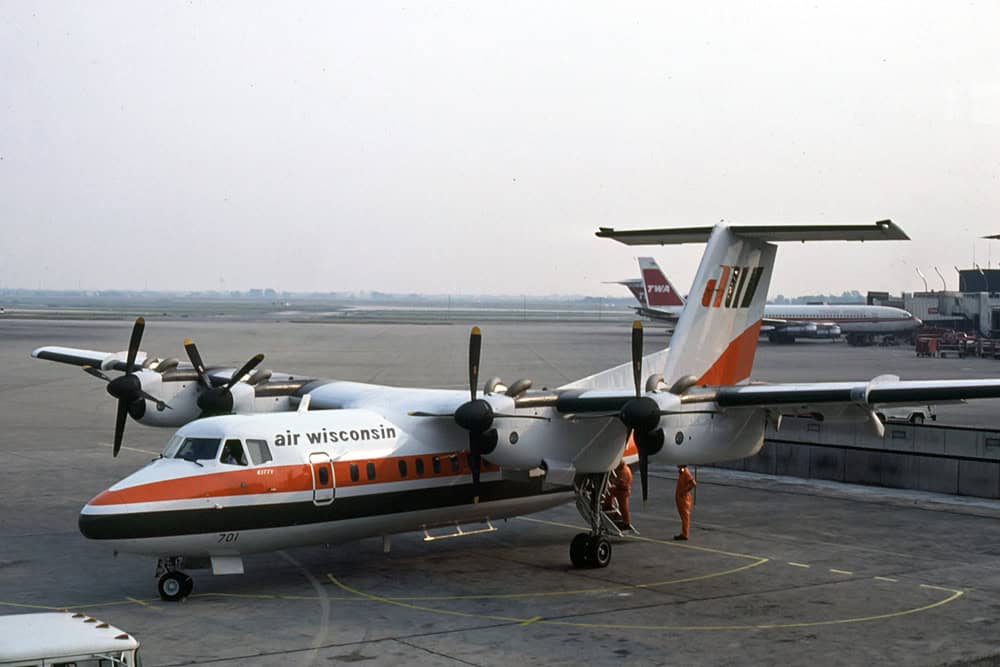The de Havilland Canada DHC-7, which was later named “Dash 7,” was the seventh and then-largest capacity aircraft to emerge from the Toronto and Downsivew, Ontario, manufacturer. It also served as the threshold to the turboprop regional airliner market, but incorporated the same STOL features that were often needed because of Canada’s topographical challenges.
“Specializing in short takeoff transport has led de Havilland Canada into a whole new world—building small, economical airliners for the feeder and commuter services, whilst tenaciously keeping the lead in short-field bush operation,” according to C. Martin Sharp in DH: A History of de Havilland (Airlife Publishing, Ltd., 1982, p.374).
DHC-7 Design Origins

1968 market studies indicated the need for a lager regional airliner to replace the DHC-6 Twin Otter or complement it on higher-demand routes. As a more ambitious design, it was to be powered by double the number of turboprop engines than its predecessor, accommodate double the number of passengers, and feature a 26,500-pound gross weight, but retain short takeoff capability.
Because it anticipated STOLport construction near city centers to avoid longer, surface journey times to existing, outlying airports, de Havilland Canada felt uniquely qualified to produce such a design that would require no more than a 2,000-foot runway.

As the seventh in the de Havilland Canada family of trainers, utility types, and transports, BAE Systems described it as “a four-engine STOL regional airliner drawing on de Haviland Canada experience with the Beaver, Otter, and Twin Otter,” according to its website.
“Designed and built by the de Havilland Aircraft Company of Canada at Downsview, Toronto, the DHC-7 was part of a family of aircraft specifically developed for use in the rough Canadian wilderness and capable of facing its wide-ranging weather conditions.”
DHC-7 Design Features
Considerably deviating from its rugged, DHC-6 Twin Otter predecessor, the larger DHC-7 featured four 1,120-shp Pratt and Whitney PT6A-50 turboprops encased in wing leading edge-mounted nacelles that drove four-bladed, fully-feathering, 11.3-foot-diameter, slow-turning (at 1,210 rpm) Hamilton Standard propellers.
Pressurized, it accommodated up to 54 four-abreast passengers in a wide-look cabin with enclosed overhead storage compartments and an aft galley, lavatory, and garment closet.
DHC-7 Takes Off
Registered C-GNBX, the first prototype first flew on March 27, 1975 and was granted its type certificate two years later, on May 2. Its short takeoff and landing performance, consisting of a seven-degree glideslope and a 35-foot landing reference height, was approved under Federal Aviation Regulations (FAR) Parts 25 and 121.
The result was a quieter, more modern, airline-standard turboprop regional aircraft in the Convair 580, Fokker F.27 Friendship, and Hawker Siddeley HS.748 class, but with STOL capabilities.
DHC-7 Operators
Launch customer Rocky Mountain Airways took delivery of its first DHC-7-100—the fourth produced—on February 3, 1978. Optimized for its tourist route structure that consisted of high-elevation, short-field ski resort-serving airports, it operated to Avon Airport, which is located in a mountain valley and provides access to Vail. As a STOLport, it was controlled by Rocky Mountain itself and was the popular destination of Denver-originating passengers.
Some of its other challenging routes included those to Steamboat Springs, whose 4,452-foot runway was at a 6,882-foot elevation, and Telluride, in the San Juan Mountains, whose 9,078-foot elevation was one of the highest in the US. It served the latter destination as a Continental Express carrier.

Other DHC-7 US operators included Air Oregon, Air Pacific, Air West, Air Wisconsin, Atlantic Southeast (ASA), Crown Airways, Era Aviation, Golden West, Gulfstream International, Henson, MarkAir Express, Paradise Island Airlines, and Rio Airways.

These and other carriers often provided two-letter code-share agreement services with major-affiliated carriers, wearing the liveries of Allegheny Commuter, Continental Express, the Delta Connection, Pan Am Express, and Trans World Express.
Hawaiian Airlines specifically constructed a 3,000-foot runway in Kapalua, Maui, for its DHC-7 operations, beginning service with the type on May 1, 1987.
Ransome Airlines, which operated independently and as both an Allegheny Commuter partner and Pan Am Express, uniquely operated from “stub” runways, particularly at Washington-National Airport, touching down on one of the nonactive or cross-strips and then holding short until ground clearance was given to taxi.
DHC-7’s Performance Enabled Additional Access
The result of an FAA-approved plan, its operation was preceded by demonstration of the Dash-7’s ability to execute a VFR approach during the loss of an engine and then bank away. Because the operation did not require the acquisition of a sometimes-unavailable landing slot, it was able to serve destinations to which it would otherwise have not had access.
Wardair of Canada took delivery of the second DHC-7 on June 8, 1978.
“Soon after, it carried Queen Elizabeth II and the Duke of Edinburgh during a royal tour in Alberta,” according to Frederick K. Larkin in “DHC-7: The Quiet STOL Multi-Tasker” (SkiesMagazine, July 8, 2019). “After that, it was hauling everything from containers of mineral concentrate and building materials to personnel and perishables.
Nine months later, the same aircraft shuttled senators and 55 tons of goods between CFB Alert on Ellesmere Island and an ice camp near the geographic North Pole.”
The DHC-7 was one of the few types certified to operate from London City STOLport, in the city’s Dockland region. Steep approaches and its short, single airstrip left Brymon Airways and London City Airways little choice but to acquire the type.
Program Conclusion
Despite the DHC-7’s flexibility, only 113 of all variants were built when production ceased in 1988, although the type certificate was ultimately transferred to Viking Air of British Columbia in 2005.
As the largest commuter-regional airliner then available, it was only attractive to carriers whose routes required 50-passenger capacities and its four engines increased operating costs over those of similar types.
The envisioned city center-proximity STOLports never materialized, leaving airlines to operate from larger, existing airports where steep approaches and low touchdown speeds were not needed.
And, perhaps creating its own competition, de Havilland Canada designed its twin-engine DHC-8 successor, which seated between 37 and 70 passengers in tis three main versions and operated longer sectors at 25-percent greater speeds on half the number of powerplants.
